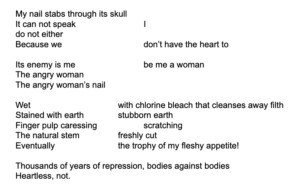Read excerpts from Hoiyan Guo’s translations of Rilke’s Briefe an einen jungen Dichter
I learned to transport myself to different places with pure imagination. When I was rereading Letters to a Young Poet, a collection of letters Rainer Maria Rilke exchanged with Franz Xaver Kappus, I saw myself peeping into a mailbox that stood alone in a garden — inside was a brown envelope in its aura. I fetched the envelope, eagerly opened it as I turned back onto the path leading to my imaginary study before I could reach a paper knife there. I held the letter extremely close to my eyes, then read it by the window.…
Starting reading Rilke’s letters with this vision becomes a ritual, even though the image does not quite correspond to my environment (I do envision moving into a nice house with a yard a lot though) nor Kappus’ (Kappus was in the military). I guess it is not about the actual surroundings, it is the act of finding, opening, and finally reading a letter addressed to a particular receiver that somehow stimulates me.
I do what I can to be a devoted reader and study the meaning of being a creative writer and translator thinking just how lovely it would be if I eventually deserve to be called one. I choose to follow Rilke, and every time I am deeply immersed in his texts, he asks me to do exactly what I did before reading him: to visualize a space for experiencing and learning, a space where I use my perception of the physical environment — weight against my body, pressure on my skin, or that feeling of being small in the middle of a vast field, to understand the intangible mental struggle in engaging the creative, the artistic, and the spiritual.
My deeper understanding of the texts was only awakened after two revisions of my own translation benefited from our class conferences. My first attempt was imbued with enthusiasm to bring forth the textual meaning, but the result did not show enough consideration to each word’s specificity, especially verbs’.
Mit nichts kann man ein Kunst-Werk so wenig berühren als mit kritischen Worten…
Nothing touches an artwork so little like a person’s critical words…
I first translated berühren into “involve” — compared to the quotidian use of berühren, namely to touch an object, the relatively abstract idea of involving something seemed appropriate in the context of engaging an artwork through critical words. Nonetheless, compared to involving, there is more specificity to the action of touching which entails the aiming of the eyes and the reaching out of an arm in order to feel the texture of the touching object. In this sentence, the gesture of touching an artwork could be interpreted as capturing the artistic essence, but however abstract it appears, the rhetoric is intended to show the endeavor and the precision the understanding of art requires. In this sense, “touch” is a more accurate translation than “involve.”
Die Dinge sind alle nicht so faßbar und sagbar…
Things are all not as easy to grasp and utter…
Both faßen and sagen describe the basic, straightforward, uncomplicated actions of catching and saying. Once again, I projected my own interpretation of the context and slightly adjusted the words’ connotation through translating them into “capture” and “articulate” at my first attempt. Similar to translating berühren into “involve” rather than a word as simple as “touch,” I constrained myself within a particular set of vocabulary relevant to literary interpretation and expression, while basic verbs more used in the daily setting would be more consistent with Rilke’s word choice.
The translation of sagen , “to say,” is a surprisingly challenging one. Throughout the paragraphs I selected for the translation exercise, sagen also appears as a motive through its variations of sagbar, unsagbar, das Unsägliches… While I find “sayable,” “unsayable,” “the unsayable” a little awkward-sounding, alternatives of translating sagen including “articulate”, “express,” and “describe” fail to convey the instinctive quality of “saying”. “Utter” remains an appropriate choice that preserves this quality.
These are only a few examples of the factors being considered during the text’s translation and revision. These brief illustrations should reveal the major challenge for my exercise, that is to translate the particular energy and tension contained in the original text through being attentive and sensitive to each word choice, especially the choice of verbs. Rilke’s verbs play a crucial role of adding physicality to the abstract intellectual world and translate the invisible inner struggle into actions that we can imagine.
Considering the texts as letters, Rilke was likely to let his thoughts on being a poet intuitively and naturally flow on paper instead of carefully constructing words and sentences to speak in a strictly academic tone. His lengthy sentences and sometimes hazy expression may not let his texts come across as a well theorized guidance for writers, but there is much inspiration in his poetic and sincere language — even though the process of writing could be complex, frustrating, and demanding of strength, what comes out of the challenge is meaningful. The experience of translating Rilke’s letters brings forward the onus on a translator to focus on not only sense but also the motion under the surface, between words. That is the only way to transmit the unseen yet tangible space constructed by Rilke to readers of the target language.




